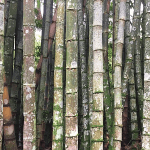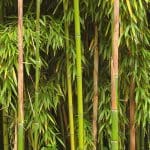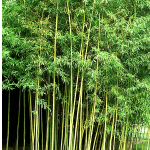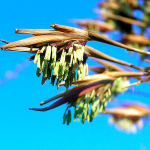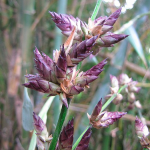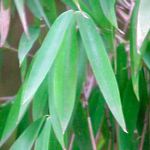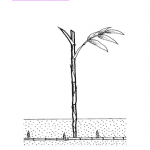Bamboo / Spring / Edible
Surprisingly bamboo can be found naturalised in the UK, it won’t grow as large as other bamboos due to our climate but can still be used.
Common Name
Broad-leaved or Arrow leaved bamboos are the two most frequently found naturalised in the UK. Many other varieties can be found planted ornamentally in parks and gardens.
Botanical Name
Sasa palmata and Pseudosasa japonica
Scientific Classification
Kingdom; plantae
Order; Poales
Family; Poaceae (Gramineae)
Physical Characteristics of Bamboo
Bamboo belongs to the grass family Poaceae. The long straight stalks of this grass can reach up to 100 feet tall, depending on species. The two species we are looking at here are fairly short in comparison to some of their relatives. The stalks are jointed and hollow, often growing in thick stands.
The stalk of the Bamboo is called a culm, (Latin for stalk is culmus). It consists of the main stem, leaves and inflorescence. The sections of the main stalk are broken down into culms and interculms, commonly described as nodes and internodes. Think of the nodes as your knuckles and the internodes as your finger between the knuckles. The internodes are hollow and the nodes are solid. The hollow sections of stalk, (the internodes), are usually airtight and have many uses.
Leaves
Broad-leaved Bamboo; 12-30 x 3.5-9 cm with 5-13 veins on either side of the midrib. The leaf sheaths are hairless, bright, shiny green with a yellow midrib. The petioles, (stalk that attaches the leaf to the plant), are greenish yellow.
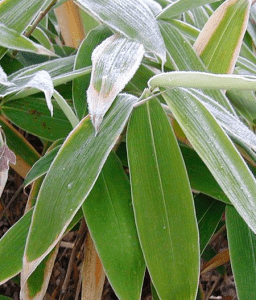
Arrow Bamboo; longer, narrower leaves, 15-35 x 2-5 cm with 5-9 veins on either side of the midrib. The sheaths are dense and roughly hairy.
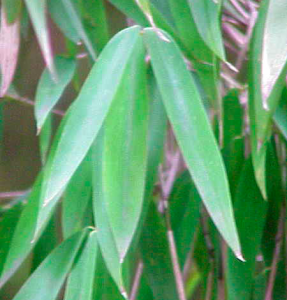
Flowers
Both species have inflorescence’s arranged in loose clusters, a little bit like Oats. They produce flowers very infrequently.
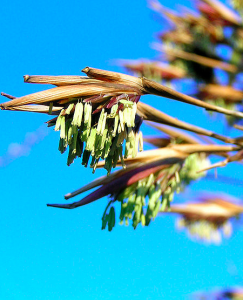
Seeds
Because Bamboo flowers very infrequently it rarely produce seeds. When it does produce seeds, they look very similar to grass seeds.
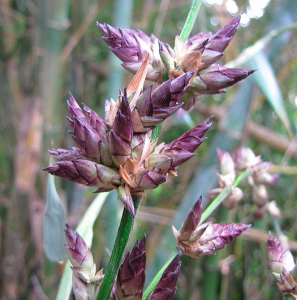
Root
The horizontal rhizomes have bumps called nodes and the sections of root between the nodes are called internodes. The lengthy roots are the main way that it spreads because they do not produce flowers and seeds for many years at a time.
There are two types of root systems, running and clumping. Clumping Bamboo root systems clump together, making them easy to grow in pots. Running Bamboo sends out long horizontal rhizomes with new shoots and new branching rhizomes that come off the nodes.
Both Broad-leaved and Arrow Bamboo have clump-forming root systems.
Habitat
Broad-leaved Bamboo introduced native of Japan. Widely cultivated and naturalised from North England to Central Scotland.
Arrow Bamboo is also an introduced species native of Japan and Korea. Frequently naturalised in Southern England and South West Wales.
Both species like damp woodland, stream and pond sides.
Known Hazards
Must be cooked or fermented prior to consumption.
Could be confused with
Fairly distinctive. There are no other grass species in the UK that look like this. The young shoots of Japanese Knotweed could possibly be mistaken for Bamboo but as both are edible, there is no risk of poisoning, although there are considerations to be taken if harvesting Knotweed.
Edible Use
The very young leaf shoots are the edible part of the plant. Remove the outer covering and the inner part can be enjoyed boiled or stir fried. You can also ferment or pickle the shoots and because they are hollow, they can be stuffed with savoury things such as mushrooms and rice or spiced minced meat.
The seeds are also edible but it is very rare that you will find them in the wild. If you do, they can be ground up and added to flour or for thickening sauces.
Notes on Herbal uses
In traditional Chinese medicine, bamboo shoots are used to ease labour and the expulsion of the placenta by inducing uterine contractions. A poultice of Bamboo shoots is often used for cleaning wounds and healing infections. Bamboo shoot decoction, taken with honey, is used to treat respiratory disorders.
Extra notes from the Foragers
With its characteristically hollow stems, Bamboo represents enlightenment in Buddhism. Once we have learned to embrace emptiness we become a vessel for the universal spirit. Once free from worldly attachments, we begin to find relief from suffering and attain real wisdom, according to Buddhist beliefs.
Because Bamboo is very strong and fast-growing, it is associated with fertility, long life, and immortality across Asia and there are a great many myths and legends associated with Bamboo.
You can check some of them out here;
The etymological root of the binomial name Sasa is from the Japanese name for certain dwarf bamboos. Palmata is derived from the Latin palmatum meaning ‘palm like’, in reference to the leaves.
Pseudo means fake or impersonator. So Pseudosasa refers to the similarity between Broad-leaved and Arrow Bamboo, but they are not the same plant and japonica is where the plant originated.
Harvest bamboo shoots by digging around them and cutting them off just above the rhizome. Clean the shoots and peel the outer sheaths. As you get closer to the soft edible core, as you remove the sheaths, you’ll notice the bottom of some of the sheaths will be white or a very light colour. Don’t discard these. They can be cut from the tough part of the outer sheath and made into Bamboo crisps.



